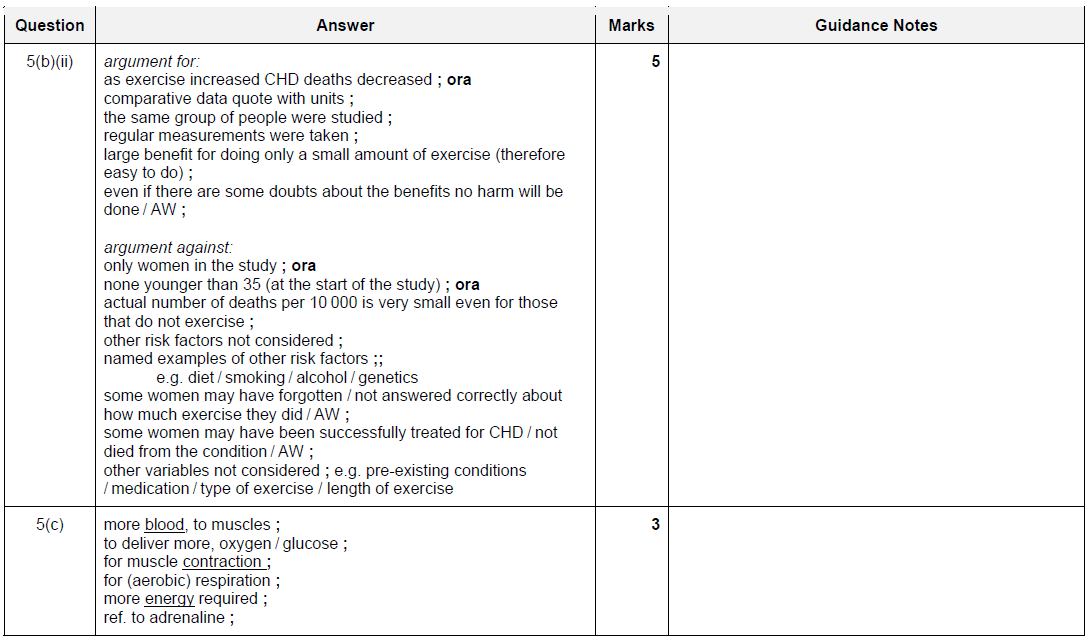Question
(a) Fig. 8.1 shows a diagram of the human circulatory system.
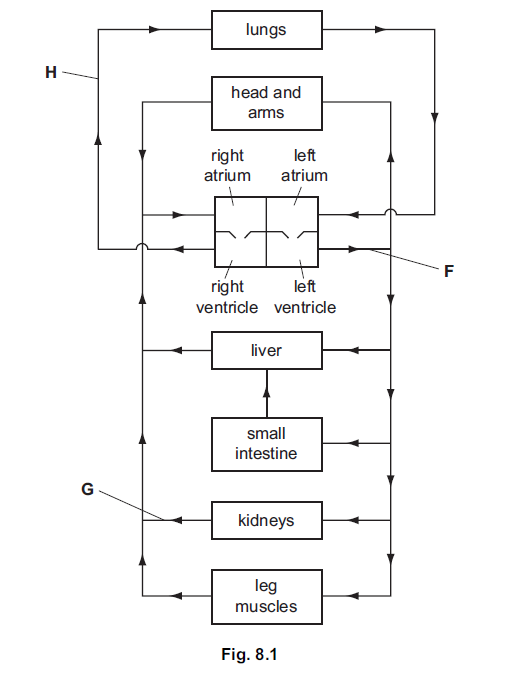
Name the blood vessels labelled F, G and H as shown on Fig. 8.1.

(b) State two ways in which the blood entering leg muscles differs from the blood leaving
leg muscles.

(c) Humans have a double circulation, as shown in Fig. 8.1.
Explain the advantages of humans having a double circulation.

Answer/Explanation
Ans:
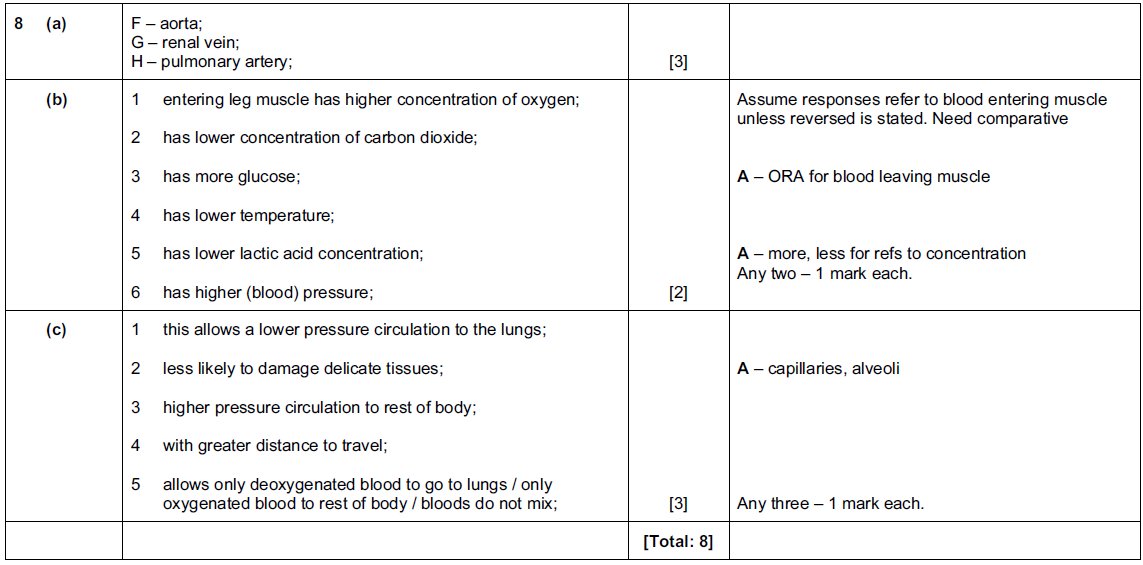
Question
Fig. 2.1 shows the average body mass and the average heart rate of nine mammals.
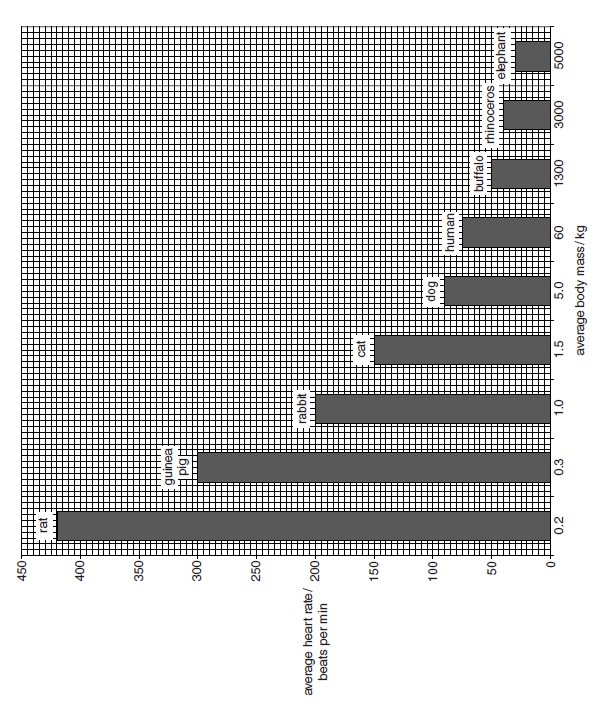
(a) (i) Name the mammal that has an average body mass of 1300 kg.
…………………………………………………………………………………………………………………….. [1]
(ii) State the average heart rate of a guinea pig.
……………………………………………. beats per minute [1]
(iii) Name the mammal that has an average heart rate of 30 beats per minute.
…………………………………………………………………………………………………………………….. [1]
(iv) Calculate how many times faster the heart of a rabbit beats than that of a buffalo.
Show your working.
……………………………………………. [2]
(b) Describe the relationship between average body mass and average heart rate, shown
in Fig. 2.1.
…………………………………………………………………………………………………………………………………
……………………………………………………………………………………………………………………………..[1]
(c) When the heart beats, it pumps blood round the body.
Fig. 2.2 shows the components of blood as seen through a light microscope.
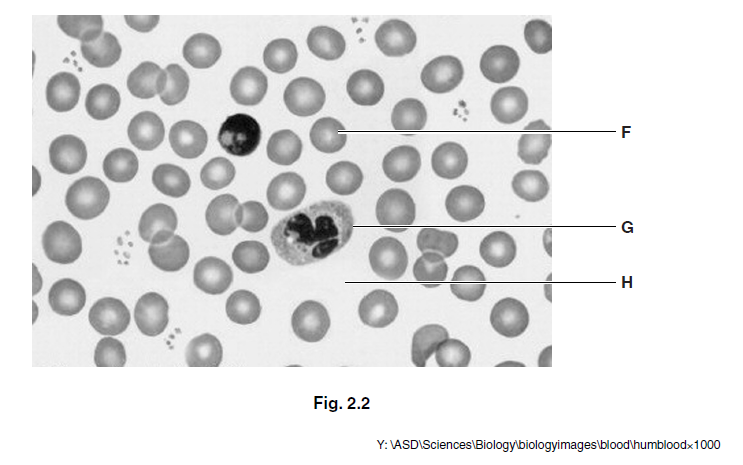
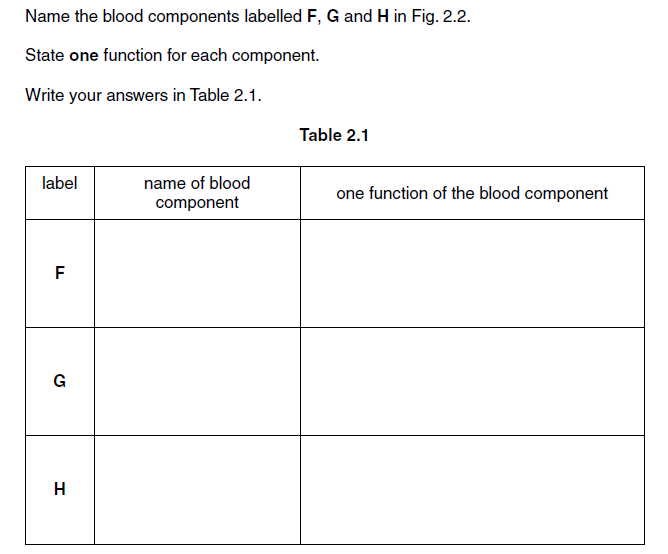
[6]
(d) Fig. 2.3 shows a diagram representing part of the human circulatory system.
The arrows indicate the direction of blood flow.
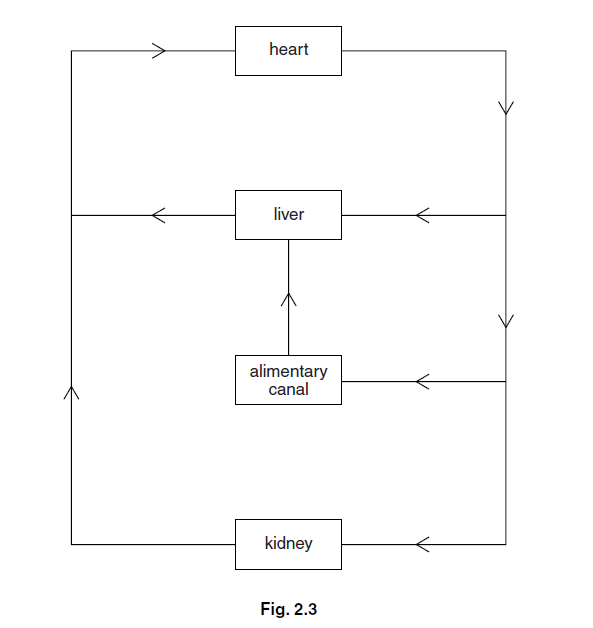
On Fig. 2.3, label the lines that represent:
• the aorta;
• the hepatic portal vein.
[2]
(e) Some students carried out an investigation into the effect of exercise on heart rate.
Their results are shown in Table 2.2.
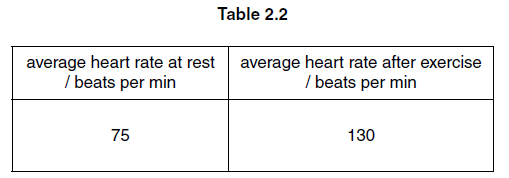
Explain why exercise caused the average heart rate to increase.
…………………………………………………………………………………………………………………………………
…………………………………………………………………………………………………………………………………
…………………………………………………………………………………………………………………………………
…………………………………………………………………………………………………………………………………
…………………………………………………………………………………………………………………………………
……………………………………………………………………………………………………………………………. [3]
Answer/Explanation
Ans:
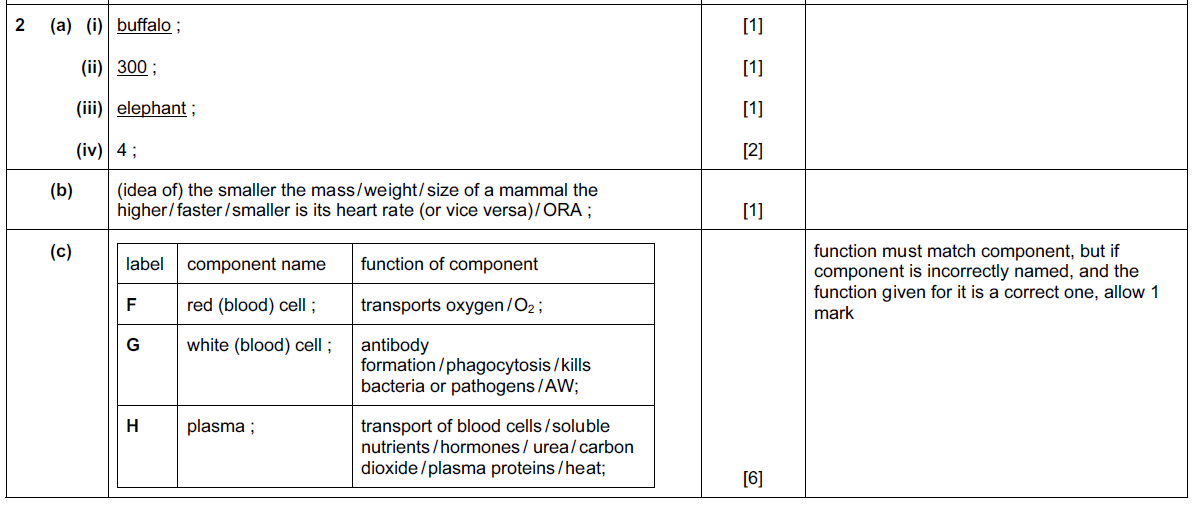
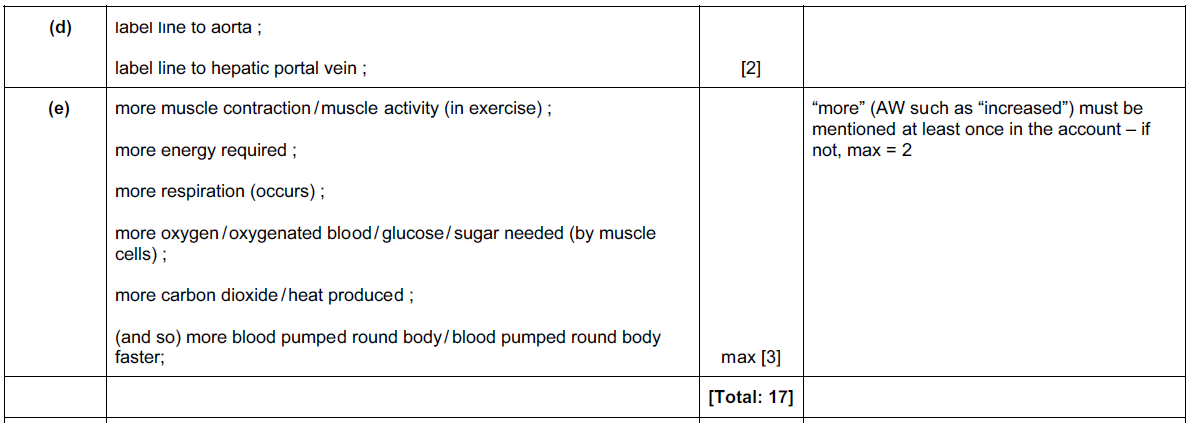
Question
Fig. 4.1 shows part of the circulatory system of a fish.
The arrows show the direction of blood flow.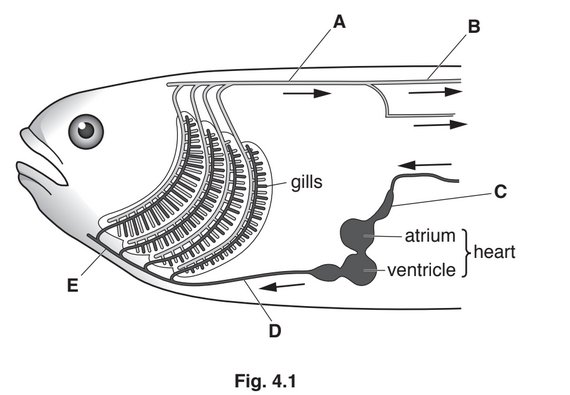
(a) The circulatory system of fish is described as a single circulation.
State what is meant by a single circulation.
…………………………………………………………………………………………………………………………………
(b) State the letter of the blood vessel in Fig. 4.1 that contains blood at the highest pressure.
……………..
(c) The gills are the site of gas exchange.
State two features of gas exchange surfaces.
1 ……………………………………………………………………………………………………………………………….
…………………………………………………………………………………………………………………………………
2 ……………………………………………………………………………………………………………………………….
…………………………………………………………………………………………………………………………………
Answer/Explanation
Ans: 
Question
Fig. 5.1 shows an angiogram of a heart before and after treatment for coronary heart disease
(CHD). An angiogram is an image of the blood flow through the blood vessels of the heart.
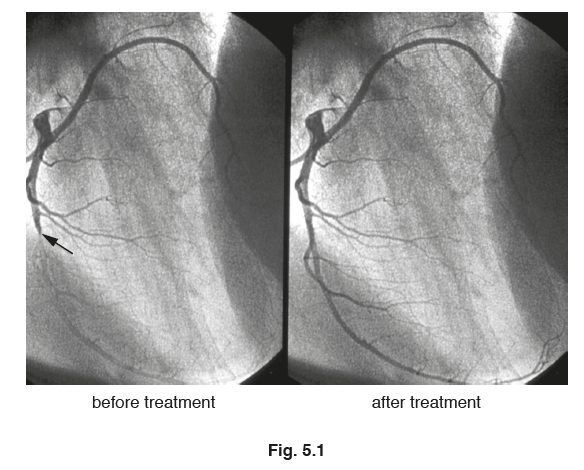
(a) The arrow on Fig. 5.1 shows the position of a blockage in a blood vessel.
(i) State the name of the blocked blood vessel.
……………………………………………………………………………………………………………………. [1]
(ii) The blockage is caused by a blood clot.
Describe how a blood clot forms.
………………………………………………………………………………………………………………………….
………………………………………………………………………………………………………………………….
………………………………………………………………………………………………………………………….
………………………………………………………………………………………………………………………….
………………………………………………………………………………………………………………………….
………………………………………………………………………………………………………………………….
……………………………………………………………………………………………………………………. [3]
(iii) State the name of a drug that can be used to treat coronary heart disease.
……………………………………………………………………………………………………………………. [1]
(b) Many health specialists think that the risk of coronary heart disease can be reduced by doing
regular exercise.
A long-term study of a large group of women was used to test this hypothesis.
The women were between 35 and 45 years old at the start of the study.
Every two years the same group of women were asked how much they were exercising.
After 28 years the researchers analysed their data:
• They calculated the average time spent exercising per week by each woman.
• They put the women into categories determined by how much exercise they had
done.
• For each category, they calculated the number of women who died from coronary
heart disease (CHD).
The results are shown in Fig. 5.2.
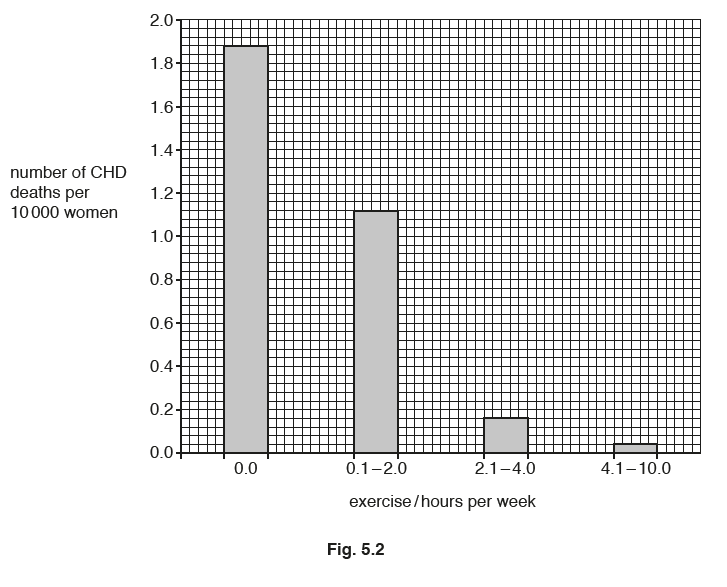
(i) Calculate the percentage decrease in the number of CHD deaths per 10 000 women
between those who did no exercise and those who exercised for 4.1 to 10.0 hours a
week, using the data in Fig. 5.2.
number of CHD deaths per 10 000 women who did no exercise …………………..
number of CHD deaths per 10 000 women who did 4.1 to 10.0 hours per week of exercise
…………………..
Give your answer to the nearest whole number.
Space for working.
………………………………………………….. %
[3]
(ii) Health professionals wanted to use the results of this study to encourage the whole
population to take more exercise.
Discuss the arguments for and against health professionals using this study in this way.
Use the information about how the study was designed and the results in Fig. 5.2 in your
arguments.
………………………………………………………………………………………………………………………….
………………………………………………………………………………………………………………………….
………………………………………………………………………………………………………………………….
………………………………………………………………………………………………………………………….
………………………………………………………………………………………………………………………….
………………………………………………………………………………………………………………………….
………………………………………………………………………………………………………………………….
………………………………………………………………………………………………………………………….
………………………………………………………………………………………………………………………….
………………………………………………………………………………………………………………………….
……………………………………………………………………………………………………………………. [5]
(c) Exercise causes heart rate to increase.
Explain why exercise causes an increase in heart rate.
…………………………………………………………………………………………………………………………………
…………………………………………………………………………………………………………………………………
…………………………………………………………………………………………………………………………………
…………………………………………………………………………………………………………………………………
…………………………………………………………………………………………………………………………………
…………………………………………………………………………………………………………………………………
…………………………………………………………………………………………………………………………… [3]
Answer/Explanation
Ans:

